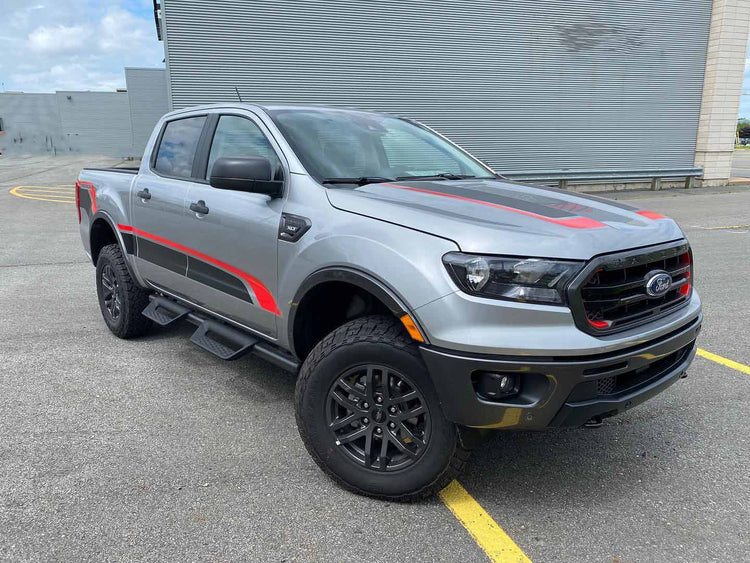Choosing between a long bed and a short bed can significantly impact how you use your vehicle. Whether you own an F-150, F-250, or F-350, bed size is crucial in the truck’s hauling capacity, maneuverability, and overall usability. This guide compares long-bed and short-bed configurations specifically for Ford trucks and provides detailed insights to help you make an informed decision, especially when considering aftermarket upgrades like bed racks, tool boxes, or bed drawers.

Ford Truck Bed Sizes: F-150, F-250, and F-350
Ford offers various bed lengths for its trucks, depending on the model and trim level. Below are the standard bed size options for the F-150, F-250, and F-350:
Ford F-150 Bed Sizes
-
Short Bed (5.5 feet):
- Cargo Volume: 52.8 cubic feet
- Overall Length (Crew Cab): ~231.7 inches
- Ideal for: Daily drivers, urban environments, and occasional light hauling.
-
Standard Bed (6.5 feet):
- Cargo Volume: 62.3 cubic feet
- Overall Length (Crew Cab): ~243.7 inches
- Ideal for: Versatile users who need a balance between cargo space and maneuverability.
-
Long Bed (8 feet):
- Cargo Volume: 77.4 cubic feet
- Overall Length (Crew Cab): ~266.2 inches
- Ideal for: Contractors, heavy-duty hauling, and towing.
Ford F-250 and F-350 Bed Sizes
-
Standard Bed (6.75 feet):
- Cargo Volume: 65.4 cubic feet
- Overall Length (Crew Cab): ~250 inches
- Ideal for: Drivers who need a balance between towing capacity and maneuverability.
-
Long Bed (8 feet):
- Cargo Volume: 78.5 cubic feet
- Overall Length (Crew Cab): ~266.2 inches
- Ideal for: Heavy-duty work, towing fifth wheels, and maximizing cargo capacity.
Comparing Long Bed vs. Short Bed Ford Trucks
1. Hauling and Cargo Space
-
Long Bed:
- Provides significantly more cargo space. For example, the Ford F-350 long bed can accommodate full 8-foot sheets of plywood or drywall with the tailgate closed.
- Ideal for contractors, farmers, or anyone needing to transport large or heavy items like lumber, ladders, or ATVs.
-
Short Bed:
- Smaller cargo capacity but sufficient for most daily tasks, such as hauling groceries, sports gear, or small furniture.
Here are some key data for your reference:
| Truck Model | Short Bed Cargo Volume | Long Bed Cargo Volume |
|---|---|---|
| F-150 | 52.8 cu ft (5.5 ft) | 77.4 cu ft (8 ft) |
| F-250 | 65.4 cu ft (6.75 ft) | 78.5 cu ft (8 ft) |
| F-350 | 65.4 cu ft (6.75 ft) | 78.5 cu ft (8 ft) |
2. Towing Capacity and Stability
-
Long Bed:
- Longer wheelbase provides better stability when towing heavy loads, especially on highways.
- Eliminates the need for expensive sliding hitches when towing fifth-wheel trailers.
-
Short Bed:
- Can tow smaller trailers, but the shorter wheelbase might reduce stability at higher speeds or on rough terrain.
3. Maneuverability
-
Short Bed:
- Easier to park and navigate in tight spaces like urban streets or parking garages.
- Better suited for daily commuting and off-road adventures due to its compact size.
-
Long Bed:
- More challenging to maneuver in tight spaces due to the increased length.
- Turning radius is larger, which can make parking and backing into tight spots (e.g., campsites) more difficult.
Key Data:
| Truck Model | Turning Radius (Short Bed) | Turning Radius (Long Bed) |
|---|---|---|
| F-150 | ~47.8 ft | ~51.1 ft |
| F-250 | ~56.5 ft | ~60 ft |
| F-350 | ~56.5 ft | ~60 ft |
Which Ford Truck Bed Should You Choose?

Choose a Short Bed If:
- You primarily use your truck for daily driving, light hauling, or recreational activities.
- You need a truck that is easier to park and maneuver in urban or off-road environments.
- You don’t require maximum towing or cargo space.
Choose a Long Bed If:
- You frequently tow heavy trailers or fifth wheels.
- You need maximum cargo capacity for work or recreational equipment.
- Stability, especially on highways or rough terrain, is a top priority.

